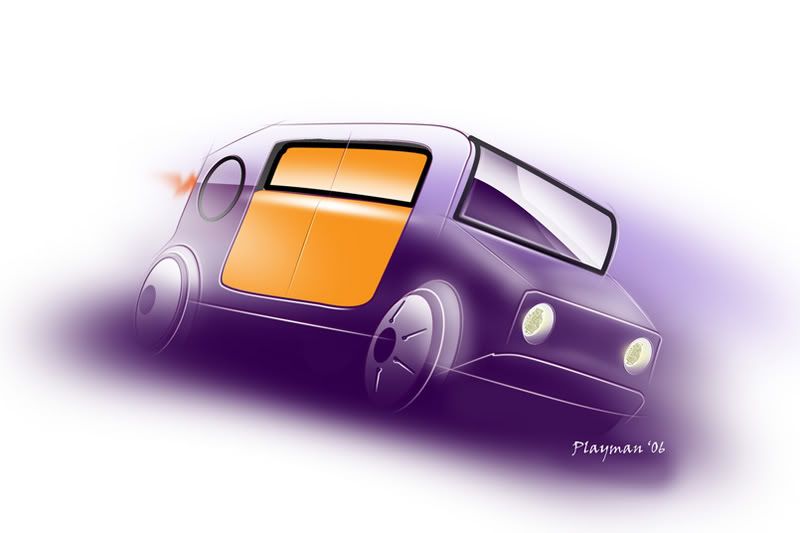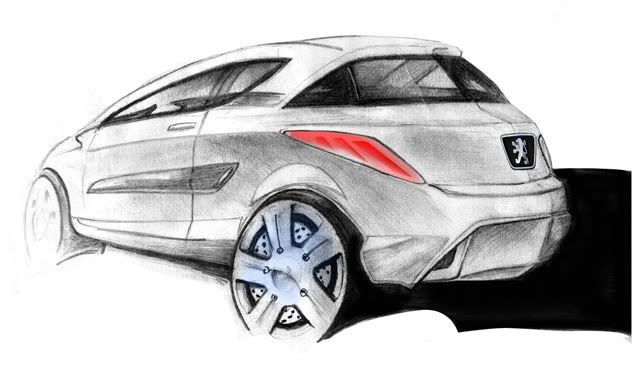 This is a concept illustration of the 1st naijacar study. It illustrations design features outline in 1st naijacar project such a design would be easily manufactured using skills and tools the nigarian car industry already has. The simplistic design shares a lot with the chrysler CCV concept , but uses a more squared of profile and surfacing.
This is a concept illustration of the 1st naijacar study. It illustrations design features outline in 1st naijacar project such a design would be easily manufactured using skills and tools the nigarian car industry already has. The simplistic design shares a lot with the chrysler CCV concept , but uses a more squared of profile and surfacing.Sunday, December 24, 2006
Illustration: 1st naijacar Project
 This is a concept illustration of the 1st naijacar study. It illustrations design features outline in 1st naijacar project such a design would be easily manufactured using skills and tools the nigarian car industry already has. The simplistic design shares a lot with the chrysler CCV concept , but uses a more squared of profile and surfacing.
This is a concept illustration of the 1st naijacar study. It illustrations design features outline in 1st naijacar project such a design would be easily manufactured using skills and tools the nigarian car industry already has. The simplistic design shares a lot with the chrysler CCV concept , but uses a more squared of profile and surfacing.Thursday, October 26, 2006
Inspiration: series 2

The most impacting inspiration. Seeing Izuogu's creation, the Z-600 in 1997 was a sign that Nigeria could do something if it wanted to. I was swallowed by emotions for the car that I failed to judge the car's design immediately. It was just good enough that a prototype was built in my country. Fast forward to 2006 and that prototype never made it to production, facing unnecessary hurdles and armed robbery. Now South Africa has shown interest in the car and want to build on it. This is where my analysis is awakened. Technically I see the stealing of the equipment to put the car into production a mixed blessing. Now I look at the car and its design is pretty old for 2006. A Z-600 version 2 would have a far better chance of surviving taking advantage of industry developments made since 1997. I always pray Izuogu starts a new car for the venture with South Africa. Nigeria and other African nations have to think innovatively about car building and not follow what the west have already done. The mention of the Z-600 still strikes a chord in my spirit, it was what ignited my passion.
Thursday, July 20, 2006
Inspiration: series 1

This is the first of a line of inspiration series that would focus on cars that share the same spirit as the NaijaCar. This series would shed light on a car that's almost totally forgotten, the Chrysler Composite Vehicle (CCV) concept shown to the world in 1997. The objective was to design a car for China that would be cheap to build, easy to maintain and cope with rough roads. The striking thing about this car is an entire chasis made of plastic as indicated in the concept's name. The benefits of this is a car that weighs just 545kg. The manufacturing costs are also drastically reduced. The car is composed of 1100 components compared to 4000 for a regular steel car and assembly time of 6.5hrs vs 19hrs. Chrysler estimated the car to cost $6000. I like the car's simplistic design. Looks like a modern day Citroen 2CV. The engine was an air-cooled 2 cylinder 800cc. It saved weight by using a rollup fabric roof as well. There are clever touches all around the car's design. Spartan it may be, but it looked good being a basic transportation. It's just sad to see the car not make production as the idea was scrapped after DaimlerBenz took over Chrysler in 1998.
No company has followed Chrysler's footsteps since then, nonetheless analyzing the cars specifications opened my mind on the possibilities of affordable mobility without relying on outdated production assembly like PAN( Peugeot Association of Nigeria) is doing with the Peugeot 504.
Tuesday, July 18, 2006
TATA's $2200 car moving ahead
Mid last year, Tata's CEO ratan Tata announced that they are developing a people's car for India and it would sell for aorund $2200. Now they seem to be moving ahead with production starting in 2008. This is very exciting because Tata is abandoning any western preconcieved notions and taking a radical approah. Using an onsite dealership assembly. Many of it's competitors especially maruti say the feat is impossible. I thoght the same myself, until closer examination revealed that this does not only make sense, it would be the next manufacturing revolution since the Flexible factory assembly pioneered by the Japanese that allows different cars to be built on the same assembly line. Some in india are wondering if people will buy. I personally think such a strategy is excellent for naijacar to emulate.
Thursday, April 27, 2006
Project Naijacar: 1st project
Since I saw Izuogu's car on TV 9 years ago, I've always wanted to see a nigerian manufactured car manifest. I started designing my own version of the car at 10yrs old, and my design has matured or changed over time. This design is brought forward to the 1st naijaCar project. Criteria set to meet costs demands are as follows
- Space frame construction rather than monocouque ( this removes the need for expensive stamps and moulds) basically a spaceframe is like a matrix of metal welded together like a bycicle frame, this would tap into the ability of the local metal workers. monocouque chasis makes sense for large scale productions, but for a small scale spaceframe is more cost effective.
- Plastic body panels covering the metal spaceframe. the body panels are untressed and the use of plastic would use the avalability of cheap plastic moulds.
- Symmetric door design so the same front doors could be used for the rear, increasing part simmilarity and economies of scale hence lowering manufacturing costs.
- Simplistic and functional interior
- Engine mounted underneath rear seat (2cyl about 800cc 50hp, 55lbft of torque)probably air cooled eliminating radistor cost and plumbing complexities.
- Variable belt transmision
Saturday, April 22, 2006
WELCOME! to naijacar

NaijaCar.blogspot.com is an open source design and technical forum for an indigenous nigerian car. The forum would have technical discussions and design proposals put together for the most cost effective method for such a car. The now defunct Nigeria car project started after Dr. Ezekiel Izuogu showed his Z600 to the public in 1997, failed to produce a viable nigerian car. NaijaCar aims for an expedited process to realise a dream like an indigenous Nigerian car.
Nigeria is in a great position, on one hand talented engineers, mechanics and entrepreneural minds like the micro industry cluster at Nnewi. On the other, we can learn from mistakes of countries that are building an automobile industry. Cars like India's TATA models, Renault/Dacia logan, and the Sri-lankan microcar are clever examples to follow.
I call all university students, anyone who has automotive or mechanical knowledge, and Parts manufacturing companies in Nigeria to come together and think freely to make this possible. Together we can make the now virtual NaijaCar a reality.
The picture shows one of my sketches.
Subscribe to:
Posts (Atom)